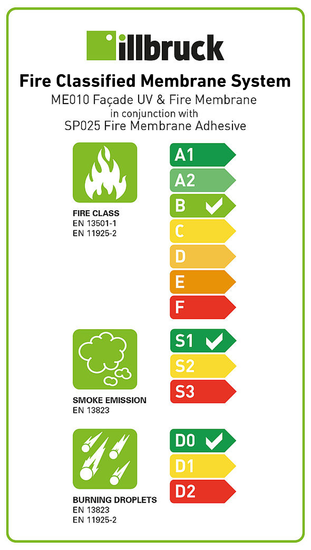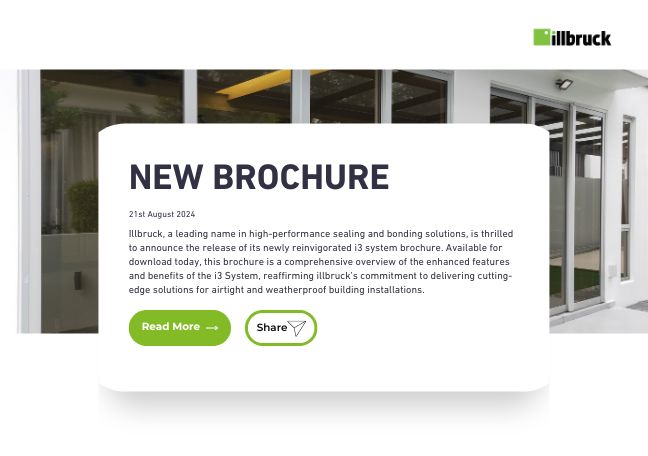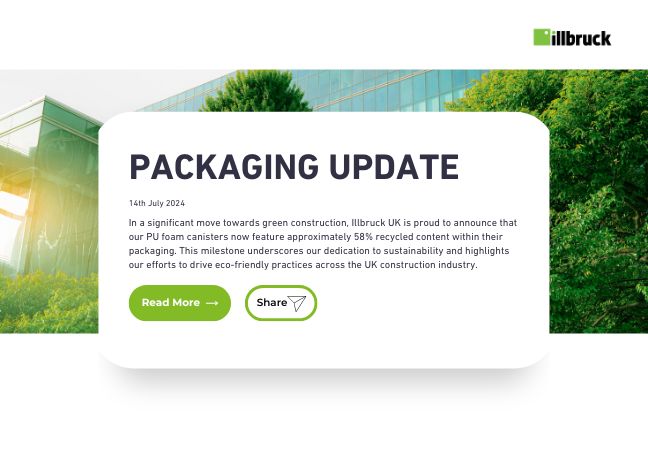Façade UV & Fire Membrane
We have A and B fire classified solutions within our product ranges including membranes and VCLs.
illbruck Façade & Fire Membranes can help ensure your project is compliant with the latest building regulations

Changes to the Building Regulations and guidance in Approved Document B (ADB) have resulted in some difficulty and ambiguity in interpretation of which materials are suitable for relevant buildings over 18 metres in height. Membranes used as part of the external wall construction above ground level should achieve a minimum of Class B-s3, d0 to EN13501-1 ‘Fire classification of construction products and building elements. Classification using test data from reaction to fire tests’.
The illbruck range includes a fully independently accredited membrane system which achieves Class B-s1, d0 to EN 13501-1.
The European Reaction to Fire classification (Euroclass) system is the common EU standard for assessing the qualities of building materials when subject to fire. The system determines a product’s fire performance by measuring a comprehensive set of characteristics, including ignitability, flame spread, heat release, smoke production and tendency for producing flaming droplets/particles. According to the European standard EN 13501-1, products will be classified in one of the seven primary classes from A1 to F according to their level of combustibility, as well as possibly belonging to additional classes according to the amount of smoke developed (s1,s2 or s3) or the amount of burning droplets or particles (d0,d1 or d2). In order to assess the appropriate classification, a product must be tested in accordance with EN 13823 (known as a ‘single burning item’ test).
‘Reaction to fire’ evaluates specific materials’ contribution to fire, whereas ‘resistance to fire’ assesses a product or system’s ability to resist the penetration through the product or system and prevent a temperature rise between the exposed and unexposed sides in a fully developed fire situation. This is more commonly declared as a fire rating. The two approaches should not be confused.
Although membranes are exempt from being non-combustible (Class A1/A2-s1,d0) via Requirement B4, Regulation 7(3), they do have to be a minimum of Class B-s3, d0 when used in ‘relevant’ buildings over 18m in height. A current Government consultation document indicates that this will reduce to 11m (in line with Scottish regulations).
The illbruck system comprises ME010 Façade UV & Fire Membrane and SP025 Frame & Façade Sealant & Adhesive, used to bond the membrane. The test was conducted by MPA Hannover. Any classification should include the method of fixing, which is clearly the case with ME010. A membrane which is classified in isolation as B-s3, d0 may have a lower classification when tested with the required adhesive. It is essential that the membrane is installed in compliance with the manner in which it was tested and classified. There is an obvious benefit and comfort for clients, specifiers and installers in knowing that there are no uncertainties associated with the specification of ME010.
ME010 fulfils various criteria in addition to meeting the reaction to fire classification. It is primarily a breather membrane – used either as a full façade application or in narrower widths as a window perimeter interface seal. The weather performance is W1 to EN1928 (before and after ageing), whilst it is also airtight and permanently UV stable – all independently assessed.
It is worth noting that whilst EPDM membranes have been widely favoured for many years for air and weathertight applications, in the context of fire, they are non-compliant with ADB, being Class E to EN13501-1. They are also not vapour permeable therefore not at all suitable for a breather membrane application.
Certain other breather membrane products have been marketed as meeting the Class B requirement, however they have not achieved the W1 water tightness level to EN1928 and the appropriate vapour resistance which should be < 0.6MNs/g.
The selection of ME010 provides a fully compliant breather membrane solution meeting EN13501-1 Class B-s3, d0 when tested as a system with proprietary adhesive and also meets W1 water resistance, permanent UV stability and the correct vapour permeability criteria.











